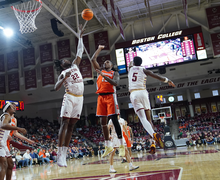PRSSA, Bateman Case Study partner to raise Lymphoma research awareness
Daily Orange File Photo
This year’s competition provided another moment for SU’s team to create connections with St. Joseph’s Hospital and OttoTHON
Get the latest Syracuse news delivered right to your inbox.
Subscribe to our newsletter here.
The Public Relations Society of America at Syracuse University partnered with the Bateman Case Study competition this year to raise awareness for the Lymphoma Research Foundation – the nation’s leading nonprofit organization for supporting lymphoma research and patient services.
According to the PRSSA’s website, the Bateman competition challenges teams of college students to research, plan, implement and evaluate a public relations campaign focused on spreading awareness on lymphoma. The competition aims to spread awareness by providing resources and connecting with those affected by the disease.
This year, public relations students were tasked with educating adolescents and young adults about supporting the foundation’s campaign efforts for funding lymphoma research. Sophie Baron, a member of Syracuse’s PRSSA who hopes to specialize in healthcare PR, said she was excited to be a part of such a campaign for that reason.
“At a previous internship, I studied Kymriah, which is a CAR-T cell therapy that treats lymphoma,” she said. “I really thought my knowledge about the disease and about the different treatments would make me a successful member of this team.”
Get the latest Syracuse news delivered right to your inbox.
Subscribe to our newsletter here.
The Syracuse PRSSA started off by hosting tabling events at the Schine Student Center and the Newhouse School of Public Communications in late February, where PR students attracted peers by offering hot chocolate. They interacted with the tables, which allowed the members of the PRSSA team to better understand their audience.
As a part of the initial round of tabling, peers would take surveys so the PRSSA team could obtain a baseline of knowledge on how to target an adolescent and young adult audience.
Peers signed pledges towards supporting the foundation as a part of a second round of tabling a week or two later designed to spread awareness of the disease. The campaign’s message was spread via social media by professors and students who interacted with the PRSSA table.
D.J. Davis, the vice president of community relations for Syracuse’s PRSSA, said one woman he met while tabling who was moved enough to share her personal story.
“That was a really powerful moment. I think in that small instance, our team realized that it wasn’t just a competition anymore — it was about trying to show our peers some important statistics and facts that can help them be more vigilant in lymphoma knowledge,” Davis said.
These surveys taken revealed that many who approached the tables were unaware of lymphoma or the Lymphoma Research Foundation. When students were asked what the most common blood cancer amongst people aged 18-39 was, the most common answer was leukemia, which demonstrated unawareness of lymphoma among this age range, Davis said.
The disease is not properly understood by this demographic, Davis said. The additional challenge of raising awareness for it compelled the Syracuse PRSSA team to make their campaign relatable to the affected adolescent and young adult audience.
Equipped with this data, the team honed their focus on strategizing the awareness campaign through social media. The team created an Instagram page that provides a helpline number in its biography for patients or anyone looking for more information. In addition, the campaign
included highlight stories with a different theme for each day of the week.
“Protect-Me-Mondays” provided information on the symptoms of lymphoma, and “Team LRF Tuesdays” showcased the Syracuse PRSSA’s triathlon team with a goal to raise up to $50,000 in support of the Lymphoma Research Foundation.
This year’s competition provided another moment for SU’s team to create connections with St. Joseph’s Hospital and OttoTHON – two organizations in central New York that support similar causes, Davis said.
“I could only imagine how this affects not just the person who has a diagnosis, but the surrounding people,” Davis said. “This competition connects resources and also tries to find support systems for families.”
The team has taken away a broad understanding of lymphoma, in which Baron also said they have hopefully reached other students and “touched them in a way that makes them be able to find the right sources.”
“It is a competition, but I think it’s more important that,” Davis said. “We, one, put our heart into it, and also give something that later teams can look at and say ‘Okay, this is what inspires us.’”

Published on April 21, 2022 at 1:03 am





